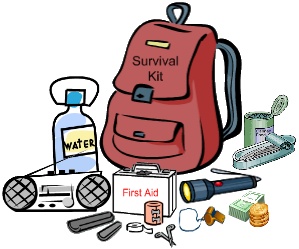Natural disasters are something we never know exactly when to expect, but should all be prepared for. There are a wide range of disasters that affect the country, locally we primarily need to be prepared for the possibilities of flooding and tornadoes. We’ve seen recent natural disasters around the country that have affected thousands of people and many of them were not equipped to take care of themselves when outside help couldn’t reach them.
Flooding can happen any season of the year. The true-blue Texas tornado season spans from April on through June, but given the right circumstances, tornadoes can spring up most anytime. With Bosque County lying at the southern end of “Tornado Alley”, a region of the central United States that is subject to an increased frequency of tornadoes, it will pay to be ahead of the curve and be well prepared for natural disasters.
The easiest thing we can do to prepare for any natural disaster is to attain and maintain a natural disaster preparedness kit. The time to prepare for disaster is now, before the time hits. A kit should contain enough food, potable water, extra clothing, food utensils, tools, and first aid to provide for every member of the household for at least 3 days. It would be better to have at least 7 days’ worth of materials as with tornadoes and extreme weather comes the issue of getting reliable electricity and clean running water back.
It is important to maintain hydration and energy during and after a natural disaster. Prepare your kit so that you have at least one gallon of potable water per person per day or the means to make water potable (i.e. filtration system, boiling, iodide tablets). A person can live without adequate food intake for several weeks but only a few days without water. Pack foods that will require very little to no preparation. Foods like protein/granola bars, dried fruits, canned chicken or tuna, canned vegetables are excellent choices for kits because they are relatively shelf stable and provide long term energy. Remember to check your kit periodically to make sure all foodstuffs, batteries, and first aid materials are still viable. The last thing you want is to dig into that kit when you need it and find half of it to be spoiled or expired.
As an old coach of mine once said, “Prior preparation prevents poor performance.” When it comes to emergency situations, having a plan beforehand is a small measure that can affect lives. A plan should include where the natural disaster kit is, where to shelter in place, and where to meet if you and your family are separated. Let family members and neighbors know your plan so that they know where and how to best help you if need be.
Coming back from a tornado or other form of natural disaster can be tough and sometimes just as dangerous as the disaster itself. If forced to evacuate your home, before returning check with local authorities to ensure that the structure is safe to enter, the gas and electrical lines are secure, and that the water supply is safe to use. Check your food supply before eating it. Dry foods should have no indication that water has gotten into them, frozen foods should have no ice crystals, an indication of thawing and refreezing, and that all cold foods have not spoiled.
For more information about disaster safety or health and wellness, contact Chris at chris.coon@ag.tamu.edu or at 254-435-2331.

